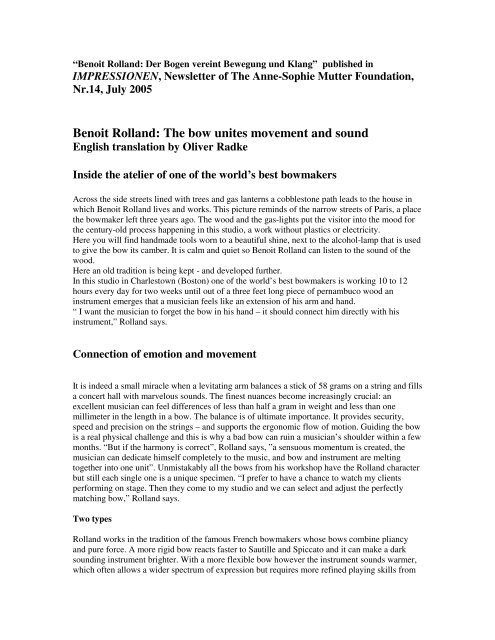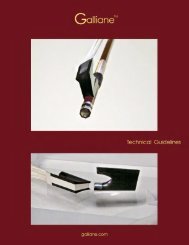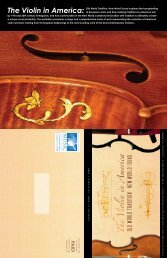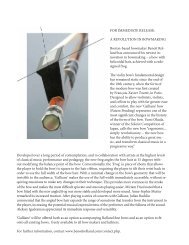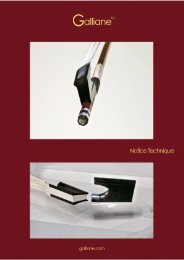Benoit Rolland: The bow unites movement and sound
Benoit Rolland: The bow unites movement and sound
Benoit Rolland: The bow unites movement and sound
Create successful ePaper yourself
Turn your PDF publications into a flip-book with our unique Google optimized e-Paper software.
“<strong>Benoit</strong> <strong>Roll<strong>and</strong></strong>: Der Bogen vereint Bewegung und Klang” published in<br />
IMPRESSIONEN, Newsletter of <strong>The</strong> Anne-Sophie Mutter Foundation,<br />
Nr.14, July 2005<br />
<strong>Benoit</strong> <strong>Roll<strong>and</strong></strong>: <strong>The</strong> <strong>bow</strong> <strong>unites</strong> <strong>movement</strong> <strong>and</strong> <strong>sound</strong><br />
English translation by Oliver Radke<br />
Inside the atelier of one of the world’s best <strong>bow</strong>makers<br />
Across the side streets lined with trees <strong>and</strong> gas lanterns a cobblestone path leads to the house in<br />
which <strong>Benoit</strong> <strong>Roll<strong>and</strong></strong> lives <strong>and</strong> works. This picture reminds of the narrow streets of Paris, a place<br />
the <strong>bow</strong>maker left three years ago. <strong>The</strong> wood <strong>and</strong> the gas-lights put the visitor into the mood for<br />
the century-old process happening in this studio, a work without plastics or electricity.<br />
Here you will find h<strong>and</strong>made tools worn to a beautiful shine, next to the alcohol-lamp that is used<br />
to give the <strong>bow</strong> its camber. It is calm <strong>and</strong> quiet so <strong>Benoit</strong> <strong>Roll<strong>and</strong></strong> can listen to the <strong>sound</strong> of the<br />
wood.<br />
Here an old tradition is being kept - <strong>and</strong> developed further.<br />
In this studio in Charlestown (Boston) one of the world’s best <strong>bow</strong>makers is working 10 to 12<br />
hours every day for two weeks until out of a three feet long piece of pernambuco wood an<br />
instrument emerges that a musician feels like an extension of his arm <strong>and</strong> h<strong>and</strong>.<br />
“ I want the musician to forget the <strong>bow</strong> in his h<strong>and</strong> – it should connect him directly with his<br />
instrument,” <strong>Roll<strong>and</strong></strong> says.<br />
Connection of emotion <strong>and</strong> <strong>movement</strong><br />
It is indeed a small miracle when a levitating arm balances a stick of 58 grams on a string <strong>and</strong> fills<br />
a concert hall with marvelous <strong>sound</strong>s. <strong>The</strong> finest nuances become increasingly crucial: an<br />
excellent musician can feel differences of less than half a gram in weight <strong>and</strong> less than one<br />
millimeter in the length in a <strong>bow</strong>. <strong>The</strong> balance is of ultimate importance. It provides security,<br />
speed <strong>and</strong> precision on the strings – <strong>and</strong> supports the ergonomic flow of motion. Guiding the <strong>bow</strong><br />
is a real physical challenge <strong>and</strong> this is why a bad <strong>bow</strong> can ruin a musician’s shoulder within a few<br />
months. “But if the harmony is correct”, <strong>Roll<strong>and</strong></strong> says, ”a sensuous momentum is created, the<br />
musician can dedicate himself completely to the music, <strong>and</strong> <strong>bow</strong> <strong>and</strong> instrument are melting<br />
together into one unit”. Unmistakably all the <strong>bow</strong>s from his workshop have the <strong>Roll<strong>and</strong></strong> character<br />
but still each single one is a unique specimen. “I prefer to have a chance to watch my clients<br />
performing on stage. <strong>The</strong>n they come to my studio <strong>and</strong> we can select <strong>and</strong> adjust the perfectly<br />
matching <strong>bow</strong>,” <strong>Roll<strong>and</strong></strong> says.<br />
Two types<br />
<strong>Roll<strong>and</strong></strong> works in the tradition of the famous French <strong>bow</strong>makers whose <strong>bow</strong>s combine pliancy<br />
<strong>and</strong> pure force. A more rigid <strong>bow</strong> reacts faster to Sautille <strong>and</strong> Spiccato <strong>and</strong> it can make a dark<br />
<strong>sound</strong>ing instrument brighter. With a more flexible <strong>bow</strong> however the instrument <strong>sound</strong>s warmer,<br />
which often allows a wider spectrum of expression but requires more refined playing skills from
the musician. Most musicians prefer one of these two types depending on their playing style <strong>and</strong><br />
technique.<br />
<strong>The</strong> <strong>bow</strong>maker works with three variables: the wood, the shape <strong>and</strong> the camber. <strong>The</strong> pieces of<br />
wood used for the <strong>bow</strong> are as different as the carving techniques that individual <strong>bow</strong>makers<br />
employ. Exceptional master <strong>bow</strong>s have been studied to develop scientific rules <strong>and</strong> processes to<br />
create the perfect <strong>bow</strong> – without success.<br />
That is why every good <strong>bow</strong> bears the individual signature of its maker. Experts can recognize<br />
the maker just by looking at how the <strong>bow</strong> tip is carved.<br />
Adjustment<br />
In medieval times the <strong>bow</strong> was bent to the outside. This round <strong>bow</strong> was still in use at the time of<br />
Bach. Around 1755 the concave camber came up that allowed a more even balance between the<br />
tip <strong>and</strong> the frog of the <strong>bow</strong> <strong>and</strong> met the desire for more expression <strong>and</strong> flexibility.<br />
This concave cambering of the <strong>bow</strong>, which gives the stick its dynamics, is in fact the critical<br />
moment in the making process. Mr. <strong>Roll<strong>and</strong></strong> is working according to the traditional method:<br />
bending over a flame. <strong>The</strong> <strong>bow</strong> is heated inch by inch, then put over the edge of the workbench<br />
<strong>and</strong> bent by the pressure of his h<strong>and</strong>s. This is how a perfect, even <strong>and</strong> smooth curve is created. Up<br />
to this moment a lot of work has already been put into the work piece; <strong>Roll<strong>and</strong></strong>’s focus is at its<br />
peak. Sometimes the valuable wood is very sensitive <strong>and</strong> the heated stick splinters like glass.<br />
Once the wood has passed the procedure of bending it is very unlikely that the <strong>bow</strong> will ever<br />
break.<br />
<strong>The</strong> development of the frog’s shape started in the 14 th century. At this time the adjustability of<br />
the frog was achieved with a metal ring that could be fastened in small groves on the outside of<br />
the stick. In the 17 th century the ring got replaced by a gear rack, the “Cremaillere”. Around 1730<br />
the modern frog appeared. It can be adjusted with a screw <strong>and</strong> it is still in use today.<br />
Awards<br />
Famous musicians are connected to <strong>Roll<strong>and</strong></strong>’s works of art: among those for example Stephan<br />
Grapelli, Arthur Grumiaux, Yehudi Menuhin, Mstislav Rolstropovitch, Joseph Suk, Henrik<br />
Szering or Jean-Luc Ponty. In 1979 the French President Valery Giscard d’Estaing awarded him<br />
the title “Meilleur Ouvrier de France”, in 1983 the award of “Archetier d’Art” followed. Aside<br />
from restoration <strong>and</strong> the making of classical <strong>bow</strong>s <strong>Roll<strong>and</strong></strong> also entered new terrain: in 1993, after<br />
ten years of development his “Spiccato”-<strong>bow</strong> made from carbon composite material was<br />
patented.<br />
For the Freundeskreis<br />
Contact to the Freundeskreis was initiated by our artistic advisory board member Lynn Harrell.<br />
Meanwhile Arabella Steinbacher plays a <strong>bow</strong> by <strong>Benoit</strong> <strong>Roll<strong>and</strong></strong> <strong>and</strong> currently a <strong>bow</strong> for<br />
Leonhard Elschenbroich is being created in Charlestown.<br />
Anne-Sophie Mutter placed an order with <strong>Roll<strong>and</strong></strong>. “I underst<strong>and</strong> well what she wants to have: a<br />
Maserati with the comfort of a Cadillac! This won’t be easy,” <strong>Roll<strong>and</strong></strong> says. <strong>The</strong> challenge is not<br />
so much in giving the <strong>bow</strong> a fast response, but in giving it the potential for a wide spectrum of<br />
<strong>sound</strong> colors at the same time. To achieve this he will use some of his oldest wood.


